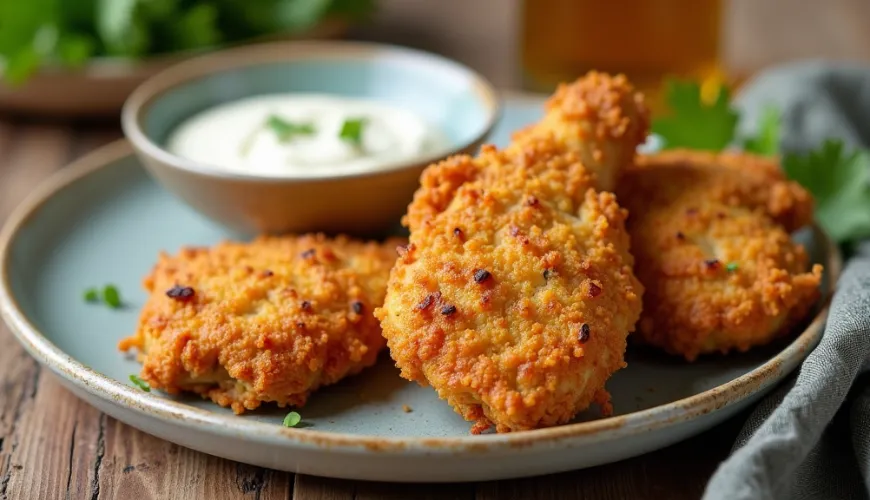
Sustainable Chicken Nuggets and Everything You Need to Know About Them

Chicken Nuggets - A Beloved Classic in a Lighter and Traditional Version
Crunchy, juicy, and incredibly versatile – chicken nuggets have long been a staple on Czech tables. Whether as a weekend treat, a quick lunch, or part of a festive table, this recipe has the ability to delight both children and adults. You might have tasted them in a restaurant or from your grandma, but did you know they can be prepared in more than one way? And that they don't have to be just about frying and heavy beer batter?
Among the most common variants are chicken nuggets in batter, often in that beer batter, which gives them their typical fluffiness and taste. But even without beer, they can be just as delicious – plus, such a recipe is more suitable for children or those who avoid beer for any reason. In this article, we'll look at different variations of chicken nuggets, how to make them healthier, and why they deserve a place in a modern, more sustainable menu.
What Exactly Are Chicken Nuggets?
Most people imagine pieces of chicken coated in batter and fried to a golden brown when they hear chicken nuggets. Chicken breast is most commonly used as it is lean and cooks quickly. The batter can take various forms – from a simple mix of eggs and flour to richer versions with beer, milk, or sparkling water. This gives the nuggets a zing and often resembles beloved fast-food bites, just in a homemade and generally tastier version.
Interestingly, the name "nuggets" has a playful and informal feel, which precisely captures their character. It's not a formal dish with a strict structure, but a meal you can adapt according to your mood, fridge contents, and diners at the table.
Classic: Chicken Nuggets in Beer Batter
The most traditional version, as known by many home cooking enthusiasts. Beer batter gives the chicken a more pronounced flavor and an airy, lightly crispy texture. The key to success is to use well-chilled beer – ideally light, not too bitter. This gives the batter gentle bubbles that create a pleasantly fluffy crust during frying.
The preparation is surprisingly simple: for the batter, you need plain flour, eggs, a pinch of salt, and cold beer. After mixing, a thicker dough is formed, into which the chicken strips are dipped and then fried in hot oil. The result is golden, crispy chicken nuggets that pair well with tartar sauce, homemade yogurt and garlic dip, or just lemon juice.
But what if you don't want or can't use beer?
Light and Family-Friendly Version
Not everyone has the desire or reason to cook with beer. Whether it's because of children, health restrictions, or simply different taste preferences. The good news is that chicken nuggets without beer can be made just as easily – resulting in a milder flavor and lighter batter.
As a substitute for beer, you can use sparkling water or soda, which also creates a light structure. Milk or plant-based alternatives like oat or almond milk work great too. The advantage is that such batter has less of an alcohol aroma and is suitable even for the youngest diners.
Experienced homemakers often add a pinch of baking powder or baking soda to the batter without beer – it makes the batter even fluffier. Instead of classic frying, you can also bake the nuggets in the oven or air fryer, which significantly reduces the amount of fat.
Can Crunchy Food Be Sustainable?
When fried foods are mentioned, most people think of something heavy, unhealthy, and unsustainable. But even traditional dishes like chicken nuggets can be made to align more closely with healthy lifestyle principles and eco-friendly households. It depends not only on the recipe but also on the choice of ingredients, preparation method, and their origin.
Instead of conventional chicken from mass production, you can use organic chicken from an ecological farm, ideally from a local farmer. Such meat not only has a better taste and texture but its production is generally less burdensome on the environment. Similarly, you can use whole grain flour, free-range eggs, and cold-pressed vegetable oil for preparation.
Even the frying itself can be done more sustainably – for example, by choosing a non-stick pan, using minimal oil, or selecting healthier fats like canola or olive oil. What's more, if you bake the nuggets in the oven, you'll save not only calories but also energy.
As renowned chef and sustainable eating advocate Jana Zatloukalová says: “We don't have to give up our favorite dishes, we just need to learn to prepare them wisely."
Tips for Perfect Chicken Nuggets
To make the nuggets perfect every time, it's worth following a few proven tips:
- Always dry the meat before coating – the batter will adhere better.
- Let the batter rest for at least 10 minutes, ideally in the fridge.
- Fry at a higher temperature – the oil should be at least 170°C to prevent the batter from soaking and to keep it crispy.
- Don't overcrowd the pan – otherwise, the oil will cool quickly, and the nuggets will steam instead of frying.
- Serve immediately – freshly fried tastes best.
Nuggets for Dinner or Lunchbox?
Chicken nuggets are suitable not only as a main dish but also work great as a warm dinner or part of a lunch box. They retain their flavor when cold and are ideal with vegetable salads, couscous, or roasted vegetables. And if you have some leftovers, you can reheat them in the oven or dry-fry them – they'll be almost as fresh.
Moreover, they can be easily frozen. Just let them cool after frying, lay them out on a tray, and put them in the freezer. Once frozen, you can transfer them to a bag for a quick lunch or dinner.
When Nuggets Taste Different
Whether you opt for the classic version of chicken nuggets in beer batter or choose the lighter version without beer, one thing is certain – this dish has its place not only in Czech cuisine but also in the modern menu. The key is to adapt the recipe to your needs and not be afraid to experiment. Try adding fresh herbs, turmeric, or a bit of Parmesan to the batter. Or marinate the meat in lemon juice and garlic before coating.
From one simple dish, you can create a tasty, versatile, and surprisingly refined dinner that the whole family will enjoy – and you can indulge in it more than once a week without guilt. Because even classics can be done differently. And well.

